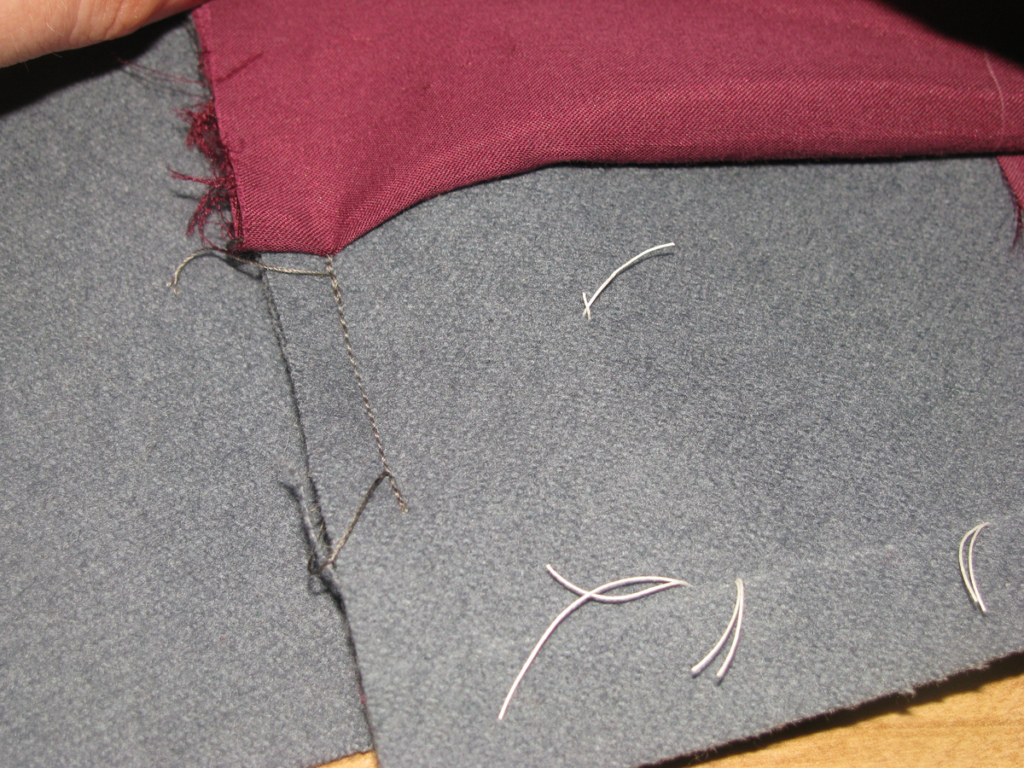Category: Double Breasted Frock Coat
Closing the Front Edge
Baste over the excess fabric in the skirt, forming a self facing.

Along the cut edge, place another row of basting stitches, to ensure everything is in place and to prevent movement when cross stitching later on.

Continue basting over the wool to the canvas. Do not pull tightly, but allow the wool to roll over naturally with a neutral tension.

At the top corner of the lapel, the wool must be mitered to reduce bulk. This can be tricky, and I highly advise practicing on some scraps before trying it out on your coat. First make an angled cut, aiming for the corner of the lapel. Fold over the other seam and trim the excess overlap. As you get more skilled, you can anticipate the angle and make the cut without having to measure. This is done by ‘rock of eye’ and isn’t something that can be taught, however.


Continue basting across the top of the lapel, ending at the center front seam that you cut open previously.

Now stoat the mitered corner closed. The stitches will not be seen, but try to keep them need and small. Close up the corner as best you can. This will be finessed when the lapel facings are attached.


Cross stitch the raw edge of the skirt to the skirt body, being careful not to let the stitches show through to the right side. At the waist seam, if you’ve cut the angle correctly, the facing should adjoin the waist seam with no gap. Here you can see I was a little off, thus the gap. If they do meet, you can stoat the two edges together. If not, just continue cross stitching.


Continue securing the wool to the canvas along the front edge, and along the top of the lapel.


Trimming the Front Edge
The front edge of the coat must now be finished off. Begin by marking a line about two inches away from the stay tape, on the skirt.

At the top of the skirt, mark a line, starting from the stay tape at 1⁄2” below the edge, tapering upwards as you go, to match the rise of the waist seam on the other side of the tape.

Along the front edge of the coat body, mark 3/8” away from the stay tape. Continue this along the top of the lapel, ending at the center front seam.


At the waist seam, just inside the chalk line, make a few stitches in place to hold the seam in place after trimming.

At the top of the center front seam, fold the canvas seam allowance out of the way, and make another stay stitch just above the stay tape.

Trim along these lines you have just chalked, starting from the skirt, along the top edge of the skirt, the front edge of the body, and the top of the lapel. When you get to the center front seam of the lapel, cut open the seam carefully with a seam ripper, to right above the stay stitches you put in place.
Taping the Canvas
After the padding is completed, lay the lapels out flat, canvas side up, and press them over a tailor’s ham. This will help smooth out any puckers or slight wrinkles, and generally firm everything up.

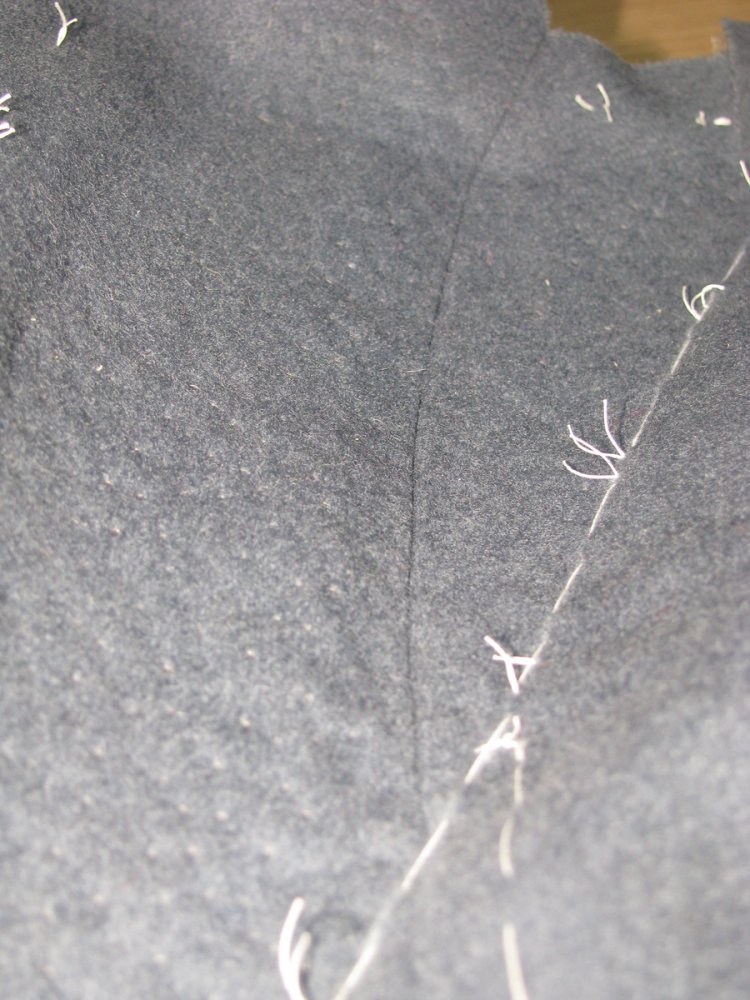
After padding the lapels, the edges of the canvas need to have linen stay tape applied, to provide a firm edge for the cloth to roll over, and also to prevent the fronts from stretching over time.
First, the seam allowance of the canvas needs to be trimmed very carefully. This should be 1/4” away from the marking stitches, or 3/4” from the edge of the wool, assuming you used a 1⁄2 inch inlay there. Begin trimming at the top of the lapel, right in line with where it is sewn to the body. As you were pad stitching, the seams on the canvas and wool underneath may have moved out of alignment. If this is the case, the canvas must be trimmed directly in line with the wool piece, or you will end up shrinking the size of the lapel. Mark the trim line with a pencil, then trim this piece as shown.

Trim down the front of the canvas, from the lapel to the waist line, by the same amount as above.

After the canvas has been trimmed, you must continue the line down the front of the skirt. The line should be continuous with the canvas, and be an equal distance from the front edge of the skirt, all the way down. You may notice that the line extends slightly in a direction away from the body, forming a very obtuse angle at the waist line. When the coat is finished, you’ll find this helps to keep the fronts of the skirt closed, with no gap showing.

Starting at about a 1/2″ above the bottom of the skirt, add stay tape to the inside of the chalk line, basting it down. You may hold the tape on slightly for the first 8 inches (only about a 1⁄4 inch of tightness is needed), to help the skirt front stay towards the body.

Continue laying the tape on top of the canvas. The tape should extend 1/16” off the edge, to reduce bulk.

When you get to the roll line, add 1⁄4” of ease in the tape, so that the lapel may roll freely. If this step is forgotten, the lapel will end up staying away from the body, giving an unsightly look.
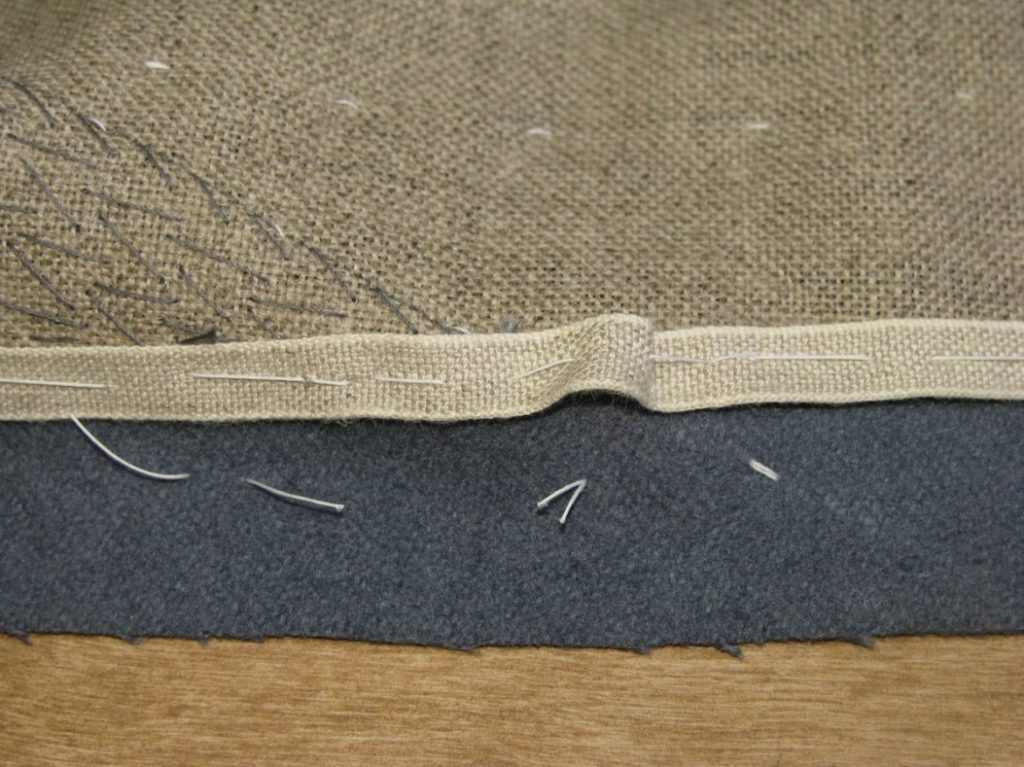
Continue taping until the top of the lapel. Here you have a sharp angle, which must be mitered to avoid bulk in this area. First trim at an angle through the stay tape, leaving just a small bit untrimmed. You should aim for the very tip of the lapel.

Next, fold the tape along the top of the lapel, and trim away the overlapping section.

Continue basting along the top of the lapel. When you get to the center front seam, make another snip in the stay tape so that you can continue basting the stay tape along the gorge line. Note in this photo how the seam of the canvas is not aligned with the seam of the wool body, as discussed previously. This is an issue I need to do more experimentation with.

Continue basting the stay tape on until half an inch beyond the roll line. Note how the stay tape is laid against the seam allowance, not the inlay marks.

Now slip stitch the stay tape to the coat along both sides, being careful the stitches do not show through to the right side.



The Bridle
The bridle is a controversial addition in an 1860s frock coat. Of the original frock coats I’ve personally examined, I haven’t found this feature yet. It may be that they were just exceptionally rare – even today, you only find them on the higher end suits. In any case, it is up to you to decide whether or not to put the bridle in.
The bridle helps with the roll of the lapel, by tightening up the chest area just outside the roll line. This has the effect of putting in another dart, which in turn makes the lapel inclined to roll more naturally.
Starting at the top of the roll line, and 1⁄4 away from the roll line baste down a length of stay tape for about three inches. At this three inch mark, make a couple of stitches in place.

For the next three or four inches, depending on the length of your roll line, hold the tape on tightly, pulling the canvas and wool into a smaller space. At the end of this section, again make a few stitches in place to prevent the ease from escaping.

Finally, for the next section, hold the tape on with a neutral tension, ending about 3 inches above the bottom of the roll line, to allow the lapel to roll freely.
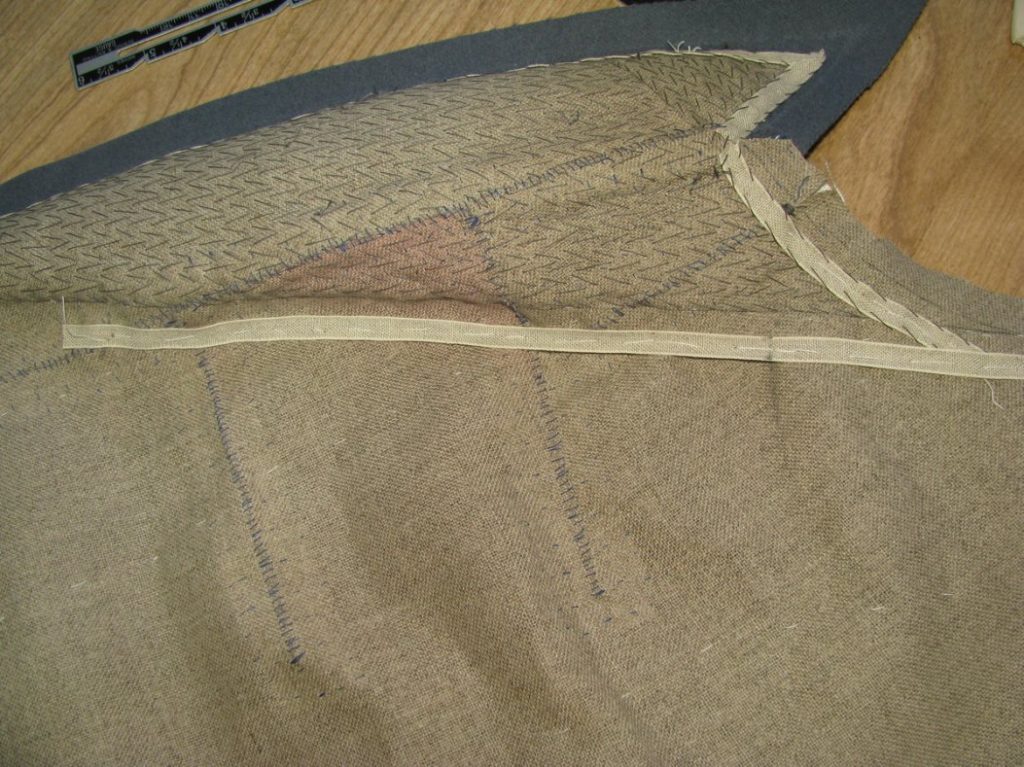
Using a cross stitch, stitch down the bridle. You should see the excess ripples of fabric disappear as you go along.

After the bridle is sewn down, you can press the lapel over the roll line. The iron should stay away from the bottom of the lapel, or you’ll remove the roll and end up with a crease instead.


Padding the Lapels
Now is the last chance to adjust the roll line of the lapel. If you wish, baste together the coat again, reinforcing the neck and armscye with stay tape, and double check the roll line. You may wish to adjust the depth. This is a completely optional step. When satisfied with the position of the roll line, chalk along the outside of the coat, staying in line with the tailors tacks. Then baste along the edge, pushing any excess upwards as you go.

On the canvas side of the coat, use a pencil to mark the roll line on the canvas. I like to use a pencil here because it is more accurate than the tailor’s chalk.
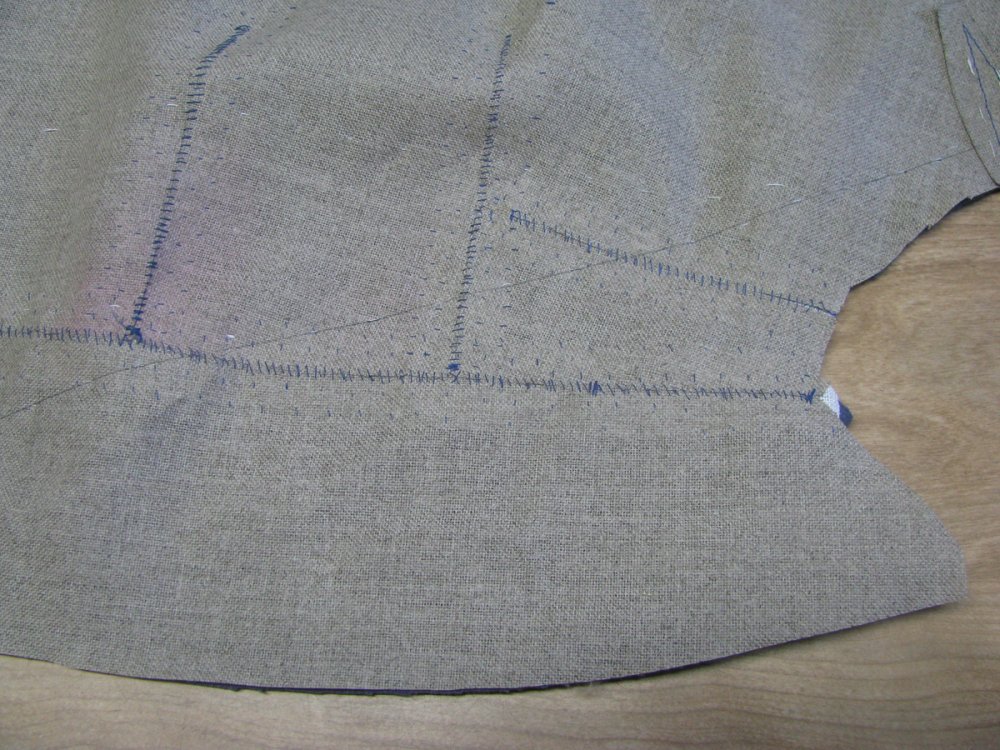
On the outside, chalk and baste along the inlays from the neck at the top of the roll line, to the edge of the lapel.

Transfer this line to the canvas side, marking in pencil, then mark in another 1⁄4 inch for the seam allowance. This is chalked only because the darts may affect the position of the neckline slightly. Along the front edge of the lapel, draw a chalk line 3⁄4 from the edge (inlay plus seam allowance). This area in between is where you will pad the lapels.

Also, draw a line continuing the neck seam line, across the bottom of the lapel ‘peak’. This will not be padded yet, but saved for afterward, as you will see.
Continue drawing the seam line all the way down the front of the coat.

Beginning at the edge of the lapel, directly next to the roll line, begin pad stitching up along the line. The needle is always pointed in the same direction, you simply work towards and away from you. The stitches should be about 3/8 inches in length, and show just a pin prick on the right side of the coat.

For the first few rows, pad the lapels while flat with the rest of the coat. As you pad, the thumb slightly pushes the canvas closer in the direction of the roll line, while the wool underneath is pulled by the fingers in the opposite direction. This is such a minuscule pull in each direction, that you shouldn’t even try it. If you’re thinking about it, you’re pulling too hard.

After the first few rows of padding, turn the coat over, and pad the rest of the lapel in the position that it will lay on the finished coat.
Note how the peak of the lapel has not been padded yet, and how the padding stops about 1/8 from the pencil lines. This is because we’ll be trimming the canvas on the pencil lines soon. When padding, you may have noticed that the canvas became shorter than the lapel underneath. This is because the canvas has to travel on the outside of the curve, thus taking up more material. To make up for this, you should redraw the pencil line, measuring the proper distance from the edge of the wool, not the canvas. Add an extra row or two of pad stitching to fill up this new space if necessary.

Padding the Lapel Peak
If you have peak lapels, as often found on double breasted coats, it must be padded separately, to ensure it stays against the body of the coat. Turn the peak over onto itself, wool sides towards each other, and pad in the direction of that line you drew. Think of it as a secondary roll line. These pad stitches should be smaller than 3/8, and get even smaller as you get towards the very tip of the lapel.

When complete, the lapels, properly padded, should want to roll over and towards the body almost naturally. The darts in the canvas should aid in this, as well.
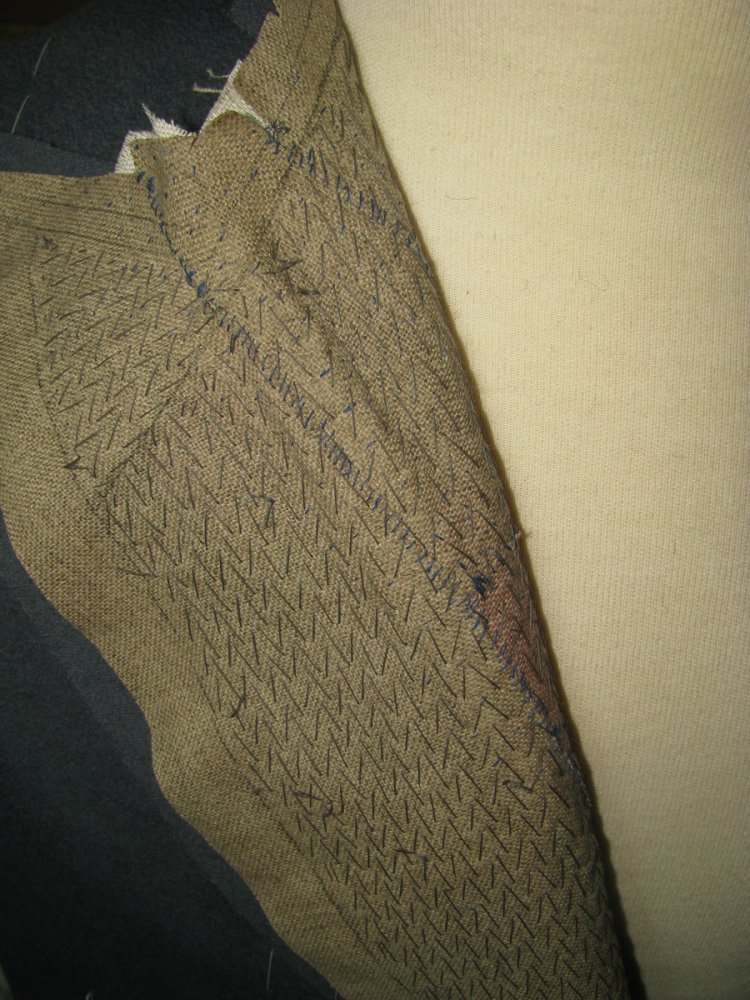
Next, we’ll tape the canvases and finish the front edge of the coat.
Installing the Canvas
Installing the canvas is a very important step. As you baste the canvas in place, all slack in the wool forepart must be eliminated, or it will show up in the finished coat.
First, lay the forepart over the canvas, with the linen side of the canvas against the wrong side of the coat, so that the center front seams of each are precisely aligned with each other. Baste from the roll line, along side the center front seam, to the waist, pushing the excess fabric downwards as you go (in the direction of the arrow). Stop about half an inch from the waist seam.

Next, from the middle of the chest, basted down, parallel to the center front, pushing the fabric downwards and towards the side seam as you go. Ensure there is no excess between the two lines of basting stitches.

From about the same height, basted down along the edge of the canvas smoothing downwards and again towards the side seam.

From the level of the second basting stitch, and midway to the first row of stitches, baste upwards, straight to the roll line, and then follow the roll line and the neck, staying out of the inlay and seam allowance, until you get to one inch below the shoulder. Since this is the fullest part of the coat, it can be the most difficult to get correct (and took me two tries). Hold one hand underneath to support the fullness as you baste. It takes some practice to get a feel for the technique.

Starting at the same level, but this time between the second and third rows of stitching, baste upward through the center of the shoulder, pushing any excess towards the armscye as you go.

Beginning at the shoulder, baste downwards along the edge of the armscye, smoothing the fabric down and out as you go. Continue basting under the armscye along the edge of the canvas until you meet the third row of stitching you basted in. There should be no excess fabric anywhere in the forepart, except for the area above the roll line. If this is not the case, you’ll need to go back and redo your basting.

Finally, baste from the roll line, down along the center of the lapel, to half inch above the waist. This completes the process of basting in the canvas. You should carefully hold the coat up at this point and look for any excess that you missed, and redo the basting if necessary.

Once you are satisfied with the result, trim off the extra canvas from the center front, neck, shoulder, and armscye. Once this is done there is no room for adjustment, so be sure you are happy with the results first.
Turn the coat to the inside, and observe the waist seam. There should be about an inch extra inlay, which will need to be trimmed off carefully so that the end of the canvas is flush with the seam line.

With your scissors in the ‘ditch’ of the waist seam, carefully cut away this extra canvas. Cut a little bit at a time, and check between each cut that you are cutting accurately. If you cut too much away, the coat front will be pulled upwards and give an unsightly appearance. It’s okay to leave about 1/16 inch extra canvas. The extra fullness in the canvas will keep the wool in shape.
Using a cross stitch, secure the canvas to the waist seam of the coat. This will hold it permanently in place. Stitch from the inner edge of the canvas, to about two inches from the center front, where the tailor tacks are. You can use the basting stitches holding the canvas in place as a guide.

Canvas Construction
We will now begin construction of the canvas – a large amount of work even by itself. Allow at least eight hours for constructing the two halves of the canvas.
Cut out the two center front darts, as well as the lapel dart, directly on the construction lines you drew.

Stoat each dart closed, holding the edges together with your thumb and fingers as you go. The edges must butt together, but not overlap. Because the canvas is thin, and hidden in the finished coat, it is perfectly fine to have the stitches show through to the other side.


Cut a piece of linen 1 inch by the length of the dart plus one inch. Stretch the linen to prevent sizing issues later on, and place it squarely over the dart you just stoated closed. Using a padding stitch, pad down the middle of the linen, catching both edges of the dart underneath.

Then pad down the middle of each half of the linen, then along the edges. When complete, you will have a very strong canvas, with almost no movement. The padding also adds a little more shape to the canvas, making it less pointed, and more round.

Repeat the process for the other dart, as well as the gorge dart.
Next, join the lapel canvas to the body along the center front seam, using the same stoating method. Start at the top to make sure it’s properly aligned. Because of the darts you added to the canvas, the body will now be about an inch shorter than the lapel. If you added the correct inlays to the canvas, however, this will not be a problem. Note in the photo the completed gorge dart, as well.


After all darts and lapels are sewn, it is time to make the cuts in the canvas at the shoulder, neck, and armscye. Clip directly on the lines.
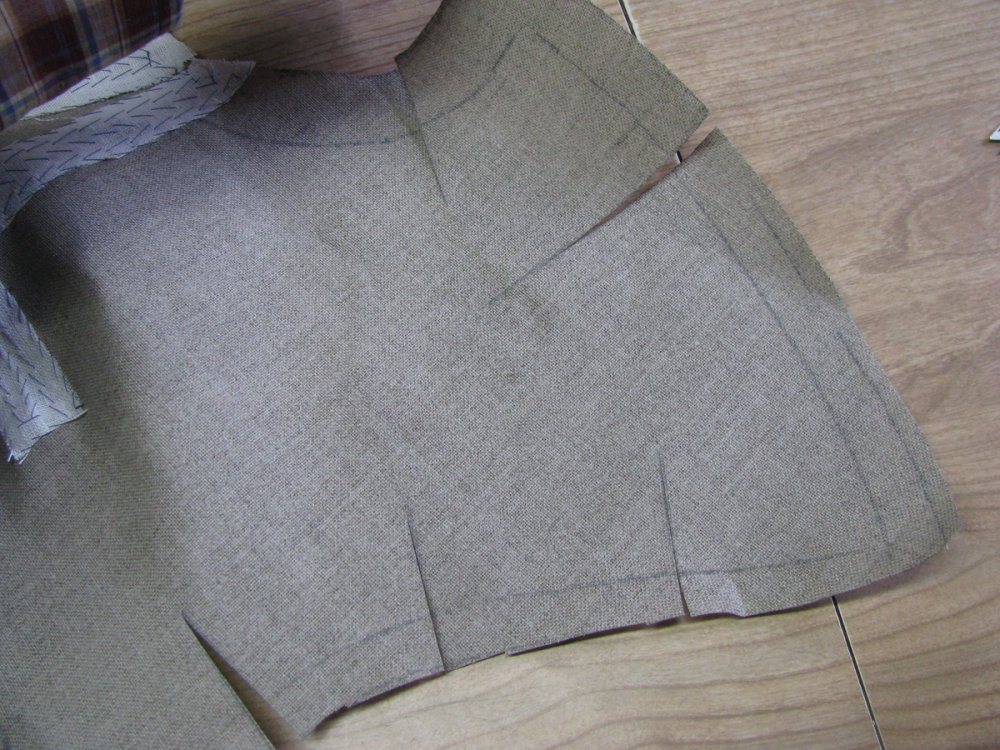
On the bias, cut 10 strips of canvas, 1 1⁄2 inch wide at the top, by half an inch at the bottom, and four inches long.

On the wrong side of the canvas (the opposite side of linen covered side), baste one edge of the bias canvas strips to one edge of the cut.

Open up the cut about 1⁄2 an inch, and baste the other side closed. This forms a gusset, copying the ironwork we put into the forepart.

Machine or side stitch the edges of the gusset closed. If using a side stitch, the stitches must be close together and pulled tightly, or there will be too much movement and the gusset may weaken over time.

Repeat the process for each of the gussets, on both canvas halves.

Trim the edges of the canvas inserts flush with the canvas itself. The canvas at this point is completed, and will now be installed into the foreparts of the coat.

Cutting the Canvas
It is time to prepare and install the Canvas. All of the iron work you put into the forepart of the coat needs to be reinforced and secured by shaping in the canvas, making it a very important part of the coat. To begin, place your paper forepart pattern on the pre-shrunk canvas. You should trim off the seam allowance from the center front edge. Fold the side seam over as shown, so that about an inch is taken from the armscye, tapered down to the waistline, which should be 4 to 6 inches in width. The new side seam may be drawn with a concave line, curving in towards the belly of the forepart.

Next, allowances need to be made – both for the inlays and a bit extra. At the neck seam, shoulder seam, armscye, and waist, add the same amount you added for the inlays in the forepart, plus half an inch. Even if you’ve cut the inlays from the waist, for example, you still need to add them to the canvas. This will give you room for error and adjustment when installing the canvas.

I also like to draw the chest line, transferred from the pattern.
For the lapel canvas, add the same inlays plus half an inch to the bottom, front, and top. The center front seam allowance needs to be trimmed off before transferring to the canvas. The lapels and body canvas will be joined with no seam allowance.

At the center front of the body canvas, one or two darts must be drawn. Two darts will give you more fullness in the chest compared to just one. These are about 4 inches long, and 1/4 to 1⁄2 inch wide at the center front, and should be placed at the fullest part. The width also depends on how much fullness you need.

Another dart needs to be added to the place on the canvas corresponding with the gorge dart you stoated in the previous module. It’s not shown in the photo as I mistakenly left it out.
At the armscye, three lines are drawn from the edge, to about 1 1⁄4 inch past the seam line. These lines should be at right angles to the edge of the canvas. These will be later cut open and held open with a piece of canvas, mimicking the stretching to the armscye present in the forepart.
Divide the shoulder seam into thirds. At the first third from the neck, draw another line at right angles to the shoulder, about 3 inches past the seam line.
Do the same at the hollow of the neck, making this line about 1 1⁄4 inch long.
Finishing the Pockets
Now turn the coat to the right side, and baste the pleat closed. If you want a pressed pleat, now is the time to give it a good pressing over a ham. I have chose not to press mine, and will instead leave it to hang freely.

Turn to the inside of the coat, and baste the pocket across the top, just below the waist seam. You want the pocket to hang without affecting the drape of the skirts, hence the angled cut of the pocket tops.
Cross stitch the pockets to the waist seam, being sure not to let the stitches show through to the right side.

At this point, the pockets are completed, and you should remove all basting stitches from the pockets and the back lining, except for the outer edge near the waist that has not been sewn yet.
You should have two nearly identical halves of the coat now. Our next step in Module 9 is to shape the canvas and install it into the coat.
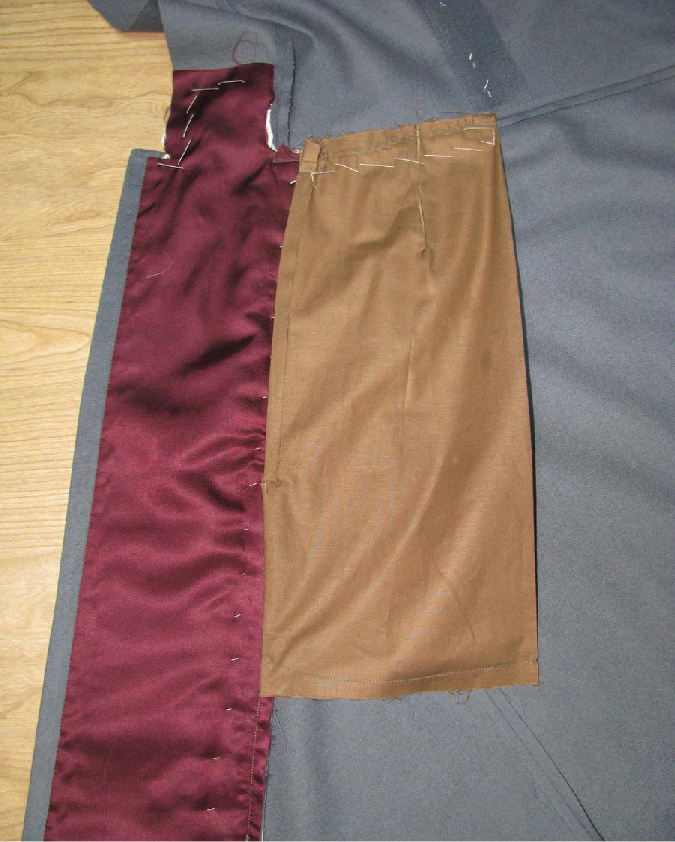


Interior Plait Pockets
Interior Plait Pockets
The interior plait pockets are a little more involved, construction wise.
At the top, very carefully clip the skirt seam allowance, 3/16 inch from the edge of the center back seam. This will help reduce bulk in this area, as otherwise you can have 6 or 7 layers in this area, giving an unflattering look.

Now baste the upper halves of the back piece and side body together. These seams must be eased together so that no ripples show on either side. The fullness will appear on one side or the other, depending how deeply you drafted the curves on these pieces.

Then baste starting from the waist down to the bottom of the skirts.

Cut a square of polished cotton twice as wide as the finished pocket pattern. Press it in half, right sides together, place your pattern along the fold, and form the darts on both sides, as explained in the exterior pocket section. You’ll end up with two darts in each pocket, pressed in opposite directions. Also be sure to mark the curved edges.
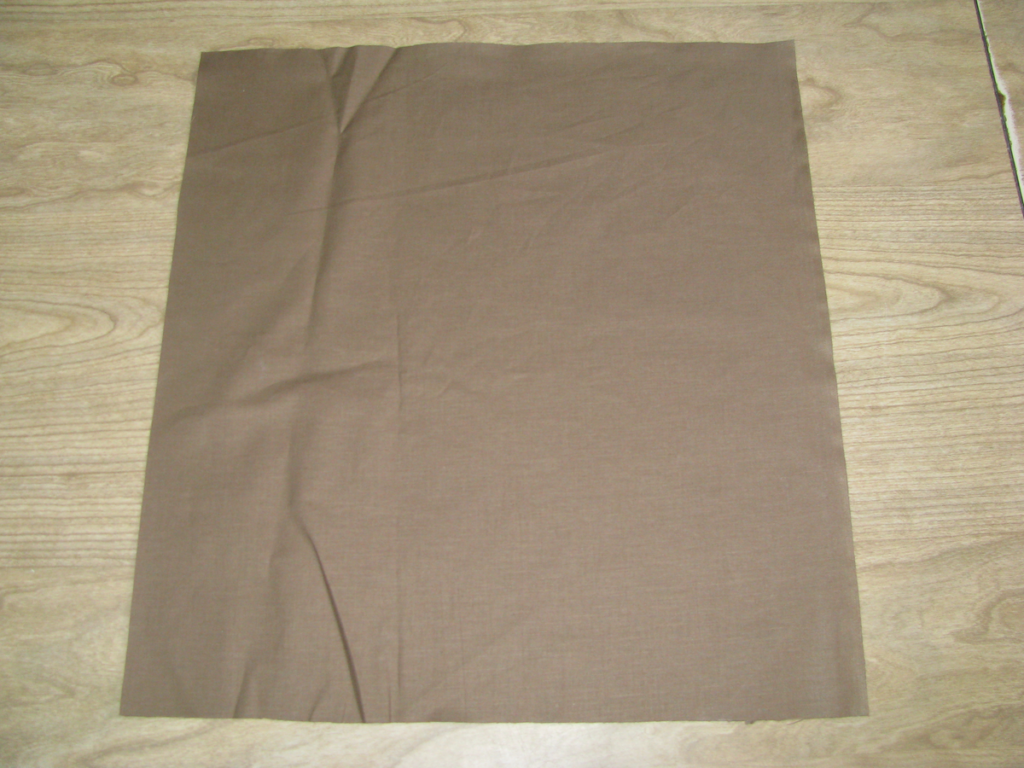

Mark on each pocket halve, 9 inches down for the length of the pocket opening. Make a cut in one half of the pocket only at this point, ¼ inch deep. Press the seam allowance from this point to the top of the pocket back towards the wrong side. Repeat for the other pocket half, being sure to do the opposite. After pressing, tack the edges together by hand just below the cut, and all the way down to the bottom of the pocket.

Place one half of the coat right side down, and arrange it so that the back piece is facing wrong side up on top of the coat.
Place the pocket with the cut edge down onto the skirt assembly. The raw edges of the pocket should be aligned with the edges of the back skirt.

Baste the pocket down, working the curve of the pocket into a straight line. When basting the upper half of the pocket, above the cut, you want to move the bottom half of the pocket out of the way, so that it is not caught in the stitching.

You can flip the pocket over to make sure that this is the case.

Now sew a straight seam, starting from 1 inch from the bottom of the skirt, to the top of the ‘step’.

This will bind all layers together, except for the upper half of the lower pocket layer, which you moved out of the way.

Remove the basting stitches from the pocket, and press the seam flat to set the stitches.
You can see how the now upper half of the pocket is still free to open.
Press the pocket back over a curved ham. The pocket has some shape to it due to the curved seam, so a ham is necessary.

Sew a tack 9 inches below the top of the pocket, just above the chalk mark you made. The tack should be just above where the cut was made, and extends from the edge of the pocket, to 1/8 away from the wool.

Make another tack at the top, about half an inch from the top. Pull the pocket slightly tight to reduce gaping in the finished pocket. These tacks are made while the pocket is still in position after pressing open.

Sew the pocket closed along the bottom edge, giving a slight curve to the stitches to make it easier to retrieve items.

Sewing the Side Body to Back
Sew the upper half of the side body to the back seam, making the little ‘step’ near the waist, and ending at the pocket, sewing all the way to the edge of the wool underneath.

Near the bottom of this seam, near the waist, make a small clip in the back piece, almost to the seam allowance. This will allow you to press the upper back seam open without issue.

Press the upper back seam from both sides to set the stitches, then using a tailors ham, press the seam open. Be sure to press this on a curved surface, otherwise you will completely ruin the coat. There is ease built into this seam, which if pressed on a flat surface, will disappear, giving you a very poorly fitted coat.

At the bottom one inch of the skirt, fold the lining out of the way, and sew the rest of the skirt closed. This will allow you to finish the lining more easily later on.

Exterior Pocket Construction
We’ll begin with the construction of the exterior plait pockets. Skip this section if you are doing exterior pockets. Begin by cutting out two pieces of polished cotton for each pocket bag. These are cut separate with the seam allowance you added when drafting. Make sure you mark the darts at the top in chalk, on both pieces.

Baste each dart closed, then stitch.

Press each dart to one side, and alternate the dart on the other half so that it is pressed in the other direction. This will help reduce bulk.

With right sides together, line the curved edge of the pocket up with the edge of the skirt, aligning each at the top. Baste firmly together.

Sew the seam with a 3/16 inch seam allowance. You want it to be slightly less than a quarter of an inch so that the seam will not be seen in the finished coat. Remove the basting stitches and press open the pocket bag.


Do the same with the other half of the pocket bag, sewing it right sides to the unfinished edge of the back skirt, again aligning at the top. Press open as you did for the other half.
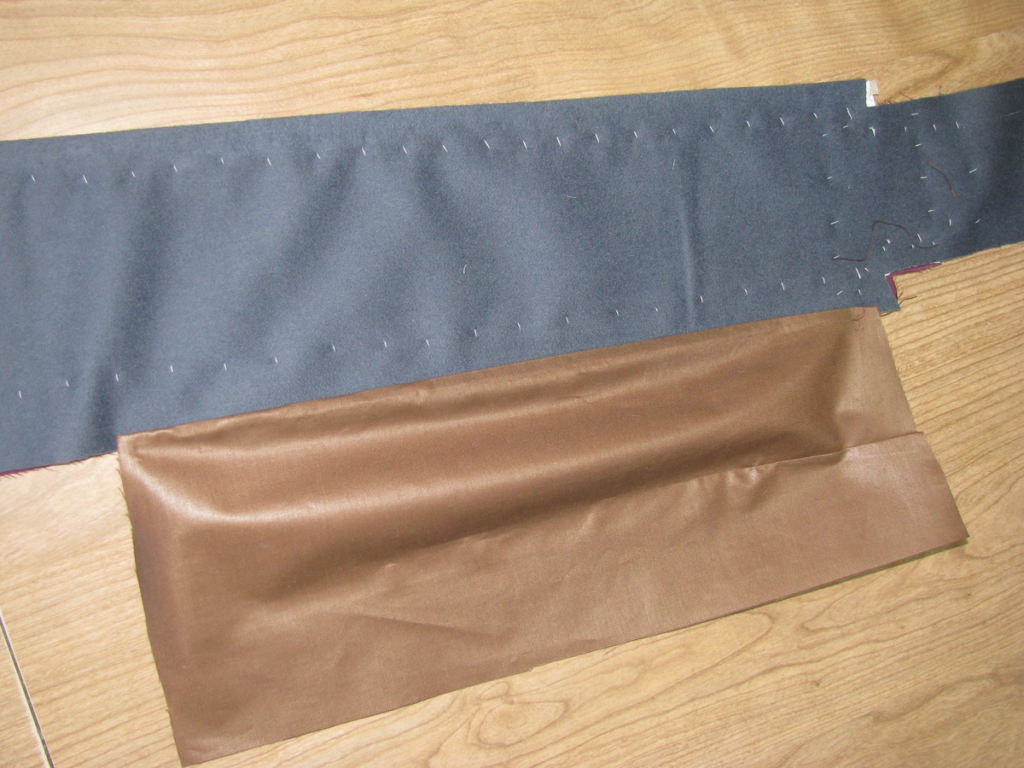
Align the back and main skirts, right sides together, making sure that the pocket bags are lined up. Baste through all layers. It’s very important that the edges of the wool layers are perfectly lined up. It’s hard to tell, as you can’t see both at once, so you’ll need to rely on touch with your fingers.

Mark on the edge of the back seam 1 inch down from the top of the pocket, and again, 9 inches from the top. This marks the pocket opening, and where you do not want to sew (or else you’ll close up the pocket).
Sew the back seam as described in the section Interior Plait Pockets. You’ll want to have side body seam basted to the upper back seam before proceeding. The only changes are that you use a 5/16 seam allowance, and stop sewing at the marks. Sew the seam from 1 inch from the bottom, to the bottom mark, and from the top mark, to the top at the waist seam.


Next, baste the pocket halves together, and sew along the edge. At the bottom outer corner, you should curve the seam nicely. Sew from the top of the pocket all the way to the bottom, ending at the 5/16 seam on the wool body.

At both chalk marks indicating the top and bottom of the pocket mouth, tack each with a row of stitching. Start exactly at the seam line and ending just past the edge of the wool, on the pocket itself. This provides extra strength for the pocket, so that it doesn’t tear as you use it.

At this point the pocket is complete, and just needs to be cross-stitched at the top, as explained in the last section.


At the top, very carefully clip the skirt seam allowance, 3/16 inch from the edge of the center back seam. This will help reduce bulk in this area, as otherwise you can have 6 or 7 layers in this area, giving an unflattering look.

Now baste the upper halves of the back piece and side body together. These seams must be eased together so that no ripples show on either side. The fullness will appear on one side or the other, depending how deeply you drafted the curves on these pieces.
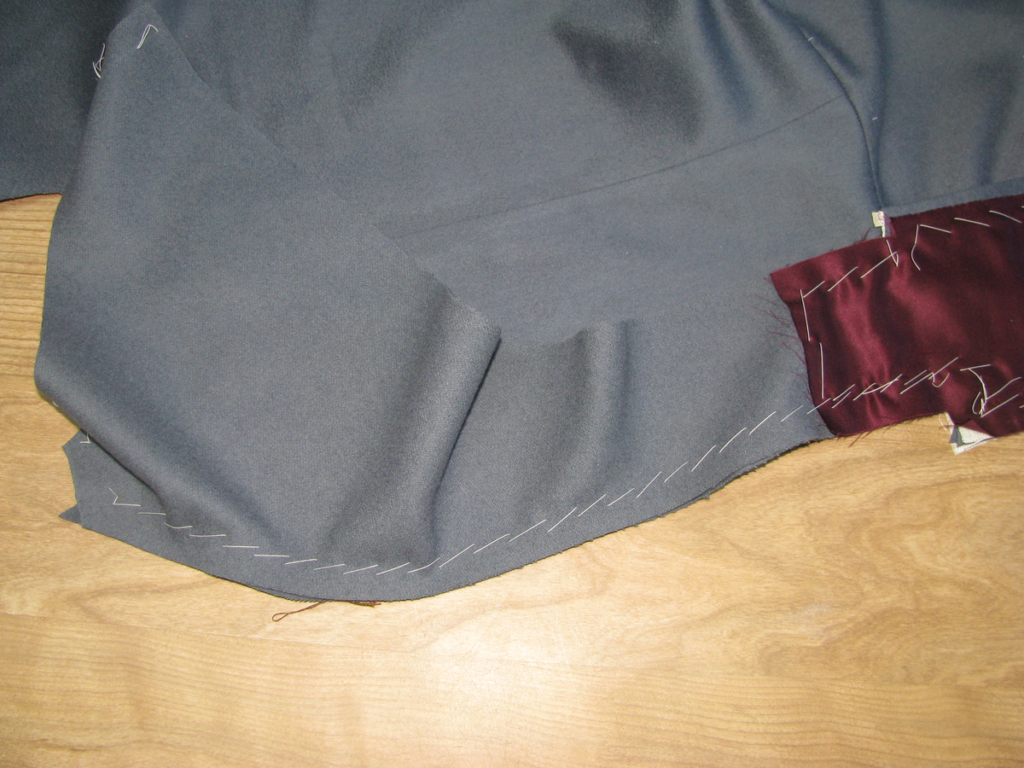
Then baste starting from the waist down to the bottom of the skirts.

Sewing the Side Body to Back
Sew the upper half of the side body to the back seam, making the little ‘step’ near the waist, and ending at the pocket, sewing all the way to the edge of the wool underneath.

Near the bottom of this seam, near the waist, make a small clip in the back piece, almost to the seam allowance. This will allow you to press the upper back seam open without issue.
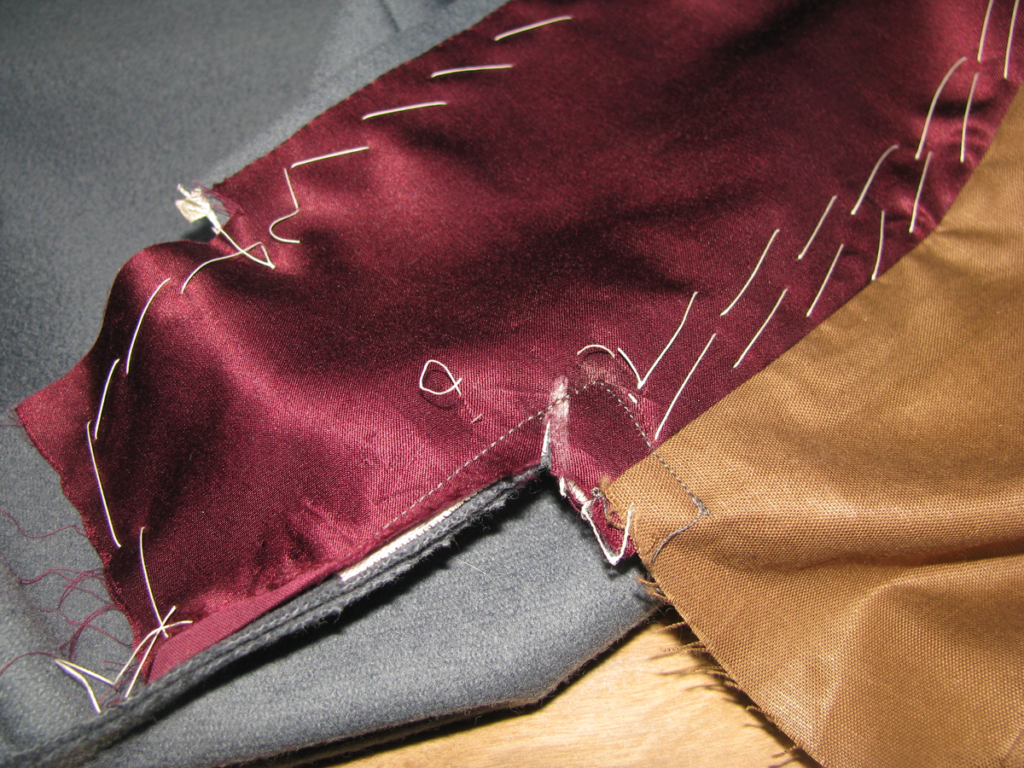
Press the upper back seam from both sides to set the stitches, then using a tailors ham, press the seam open. Be sure to press this on a curved surface, otherwise you will completely ruin the coat. There is ease built into this seam, which if pressed on a flat surface, will disappear, giving you a very poorly fitted coat.

At the bottom one inch of the skirt, fold the lining out of the way, and sew the rest of the skirt closed. This will allow you to finish the lining more easily later on.
